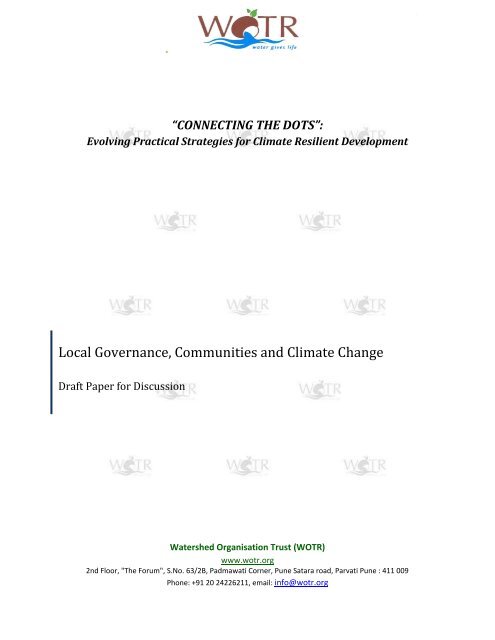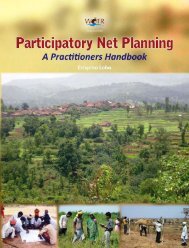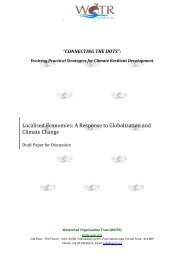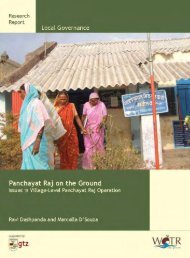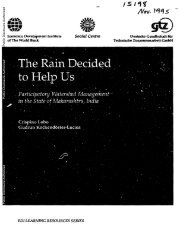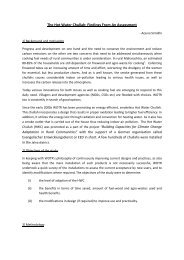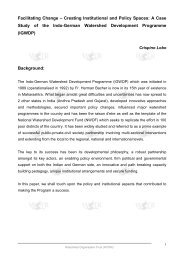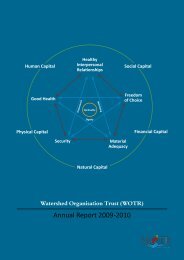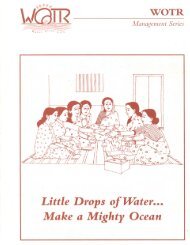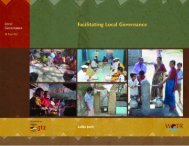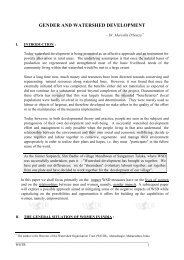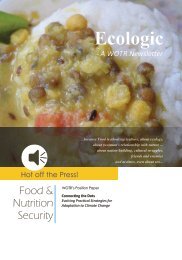Local Governance, Communities and Climate Change - WOTR
Local Governance, Communities and Climate Change - WOTR
Local Governance, Communities and Climate Change - WOTR
You also want an ePaper? Increase the reach of your titles
YUMPU automatically turns print PDFs into web optimized ePapers that Google loves.
“CONNECTING THE DOTS”:<br />
Evolving Practical Strategies for <strong>Climate</strong> Resilient Development<br />
<strong>Local</strong> <strong>Governance</strong>, <strong>Communities</strong> <strong>and</strong> <strong>Climate</strong> <strong>Change</strong><br />
Draft Paper for Discussion<br />
Watershed Organisation Trust (<strong>WOTR</strong>)<br />
www.wotr.org<br />
2nd Floor, "The Forum", S.No. 63/2B, Padmawati Corner, Pune Satara road, Parvati Pune : 411 009<br />
Phone: +91 20 24226211, email: info@wotr.org
1. Introduction:<br />
<strong>Local</strong> <strong>Governance</strong>, <strong>Communities</strong> <strong>and</strong> <strong>Climate</strong> <strong>Change</strong><br />
Each locale is unique. It is the local community living therein that best underst<strong>and</strong>s its ecospace,<br />
its situation <strong>and</strong> senses the early warning signs <strong>and</strong> symptoms of sudden or slow onset<br />
disasters. In the context of preparedness for <strong>and</strong> mitigation of crises related to climate change,<br />
four important components have to be addressed: security for water, food, energy <strong>and</strong><br />
sustainable livelihoods. The depth <strong>and</strong> range of response will depend upon the extent of<br />
vulnerability which differs according to geographic regions, location of villages <strong>and</strong> also of<br />
households within villages. Addressing these challenges falls within the purview of the local<br />
governance establishment, (the Gram Panchayat <strong>and</strong> local government agencies) <strong>and</strong> its<br />
community.<br />
It is an alert <strong>and</strong> mobilized community, supported by sensitive <strong>and</strong> empowered local governance<br />
that can take preventive measures, respond quickly, take appropriate action in times of crises<br />
<strong>and</strong> disasters <strong>and</strong> facilitate effective <strong>and</strong> speedy rehabilitation. Such an organized response is<br />
only possible when both the community <strong>and</strong> the Gram Panchayat (GP) routinely work together<br />
for achieving common goals, in the normal course of business. Yet, even where such a happy<br />
situation exists, a community cannot face exogenously driven crises altogether on its own. It<br />
needs the support of higher levels of governance (the Panchayat Samitee, the Zilla Parishad <strong>and</strong><br />
the related government agencies), for which it is necessary that linkages <strong>and</strong> good<br />
communication with these bodies <strong>and</strong> agencies be established <strong>and</strong> maintained on a regular<br />
basis.<br />
<strong>Climate</strong> change will adversely impact ecosystems <strong>and</strong> the range of environmental services<br />
available to the local communities. This in turn will affect the sustenance <strong>and</strong> livelihood<br />
prospects of rural households <strong>and</strong> the local economy which are heavily dependent on natural<br />
resources-l<strong>and</strong>, water, flora <strong>and</strong> fauna - for food, energy, shelter <strong>and</strong> income.<br />
This paper focuses on the role <strong>and</strong> challenges the local self government agencies, notably the<br />
Gram Panchayats (GP) <strong>and</strong> local communities will likely face in undertaking adaptive <strong>and</strong><br />
mitigative measures in the context of climate change.<br />
2. <strong>Local</strong> Self <strong>Governance</strong> <strong>and</strong> Adaptation to <strong>Climate</strong> <strong>Change</strong><br />
While the process of decentralization began way back in the 1950s 1 , the 73rd amendment of the<br />
Panchayat Raj in 1994, the PESA <strong>and</strong> subsequent policies have envisaged a greater role for<br />
village level PRIs - the Gram Panchayat (GP) <strong>and</strong> the Gram Sabha (GS) - in local development.<br />
Since then, various initiatives have rightly placed the GP at the centre of the development<br />
process.<br />
(i) The Common Guidelines for natural resources management (NRM) has the Watershed<br />
Committee as a sub-committee of the GP;<br />
1 The Bombay <strong>and</strong> Village Panchayat Act, 1958, is one such example which introduced the 3-tier system of<br />
governance.<br />
2
(ii) In the MGNREGS, the GP has a pivotal role in implementation, planning, allocating<br />
employment, <strong>and</strong> monitoring at the village level. In this program, various village level<br />
developmental activities that build adaptive <strong>and</strong> mitigative capacities can be<br />
undertaken.<br />
(iii) The NRLM mission places responsibility on the PRIs for identification of BPL households,<br />
their mobilization into SHGs <strong>and</strong> federations; prioritizing dem<strong>and</strong>s <strong>and</strong> allocating funds<br />
in the annual PRI plans; <strong>and</strong> executing <strong>and</strong> monitoring the works through these SHGs. 2<br />
With its focus on livelihoods, the NRLM gives an opportunity to provide sustainable<br />
livelihoods particularly for the vulnerable.<br />
(iv) The Provision of Urban Amenities in Rural Areas (PURA) Scheme 3 proposes holistic <strong>and</strong><br />
accelerated development of compact areas around a potential growth centre in a Gram<br />
Panchayat (or a group of Gram Panchayats) through Public Private Partnership (PPP)<br />
framework for providing livelihood opportunities <strong>and</strong> urban amenities to improve the<br />
quality of life in rural areas to bridge the rural-urban divide 4 .<br />
For these programs - the IWMP, MGNREGS, NRLM, PURA <strong>and</strong> the various departmental<br />
schemes, large funds are allocated. It expresses the Government’s seriousness in decentralizing<br />
governance for poverty alleviation, strengthening the resource base <strong>and</strong> creating local<br />
livelihoods. The Eleventh Schedule 5 transfers to the PRI m<strong>and</strong>ates related to 29 areas, 6 all of<br />
which are directly related to promoting development, building adaptive capacities <strong>and</strong> disaster<br />
preparedness. It is pertinent to note that all these sectors have a direct bearing in building<br />
resilience, reducing risks, mitigating disaster <strong>and</strong> crises <strong>and</strong> strengthening the adaptive<br />
capacities of local communities.<br />
Various government policies, programs <strong>and</strong> guidelines are in place that seek to address water,<br />
food, <strong>and</strong> livelihoods security as also to provide weather related products <strong>and</strong> services (such as<br />
forecasts, crop <strong>and</strong> fishing advisories), given the sensitivity of the rural economy to weather.<br />
However, the big question is: How prepared is the GP <strong>and</strong> its community to h<strong>and</strong>le their roles<br />
<strong>and</strong> responsibilities in situations where temperatures are rising, rainfall is erratic, more extreme<br />
meteorological events are occurring (droughts, dry spells, cloud bursts, cold waves, storms), all<br />
of which adversely affect ecosystems <strong>and</strong>, thus, the lives <strong>and</strong> livelihoods of rural communities?<br />
2 Mission Document, National Rural Livelihoods Mission (NRLM), MoRD, New Delhi. Available at:<br />
http://aajeevika.in/nrlm/NRLM-Mission-Document.pdf<br />
3 http://rural.nic.in/sites/downloads/budget/Outcome_Budget_2012_13.pdf. An allocation of Rs. 248 crores for<br />
pilot implementation has been provided for in the 11th Five Year Plan.<br />
4 Amenities to be provided: water <strong>and</strong> sewerage; construction <strong>and</strong> maintenance of village streets; drainage; solid<br />
waste management; skill development; economic activities; village street lighting; telecom; electricity, rural<br />
markets, agricultural services centers, etc.<br />
5 11 th Schedule to the Constitution, inserted by the 73 rd Amendment, Article 243G, accessed from<br />
http://indiacode.nic.in/coiweb/amend/amend73.htm on 30.5.12<br />
6 Such as agriculture, l<strong>and</strong> improvement <strong>and</strong> soil conservation; minor irrigation, water management <strong>and</strong> watershed<br />
development; animal husb<strong>and</strong>ry, dairying <strong>and</strong> poultry; fisheries; social forestry <strong>and</strong> farm forestry; minor forest<br />
produce; khadi, village <strong>and</strong> cottage industries; rural housing; drinking water; fuel <strong>and</strong> fodder; PDS; health <strong>and</strong><br />
sanitation<br />
3
3. Panchayati Raj Institutions: Current Experiences<br />
There are a few good experiences, across the country where GPs are efficiently <strong>and</strong> effectively<br />
utilizing financial, natural, human resources <strong>and</strong> have ignited a “spiral of progress” in their<br />
village. 7 Yet, in most of the country, GPs struggle to fulfill their m<strong>and</strong>ate <strong>and</strong> meet the basic<br />
needs of their people. It is this underdevelopment that aggravates vulnerability to climate<br />
change in rural India. Though well known, let us look at some important issues that significantly<br />
affect progress:<br />
(i) The Gram Panchayat (GP):<br />
It gets elected every 5 years. Generally, those that get elected are the same elderly men who<br />
wield power, election on election, refusing to let the younger, more capable <strong>and</strong> willing to take<br />
over.<br />
There is a 50% representation for women <strong>and</strong> a reservation for a woman as Sarpanch. While<br />
women are capable, even educated women need immense courage to assume their role in a<br />
male-dominated arena. When women become Sarpanchs, their husb<strong>and</strong>s (who usually belong<br />
to a power clique in the village) represent them in the GP, thus continuing their sway<br />
(“democratically”). Women have much to contribute, particularly to conservation in the climate<br />
change context. It is they, indeed, who provide for the bulk of household needs most of which<br />
come from nature’s goods <strong>and</strong> services. They are best attuned to events unfolding in the<br />
environment <strong>and</strong> are the first to feel their consequences. It is they also who are best placed to<br />
undertake adaptive <strong>and</strong> ameliorative measures. Sidelining them <strong>and</strong> not providing a potentially<br />
effective platform for women, such as the Gram Panchayat, to be engaged in developing her<br />
village would be a case of great opportunities lost.<br />
The GP is encouraged to have sub-committees of members who are not elected. This is to give<br />
an opportunity for educated, capable <strong>and</strong> dynamic persons to play a role in effective<br />
governance. However, the fact is that there is a severe dearth of such skilled people in a village –<br />
they would rather migrate than stay in the village. In terms of good managerial skills,<br />
accountability <strong>and</strong> reporting, capability within the village is limited. A serious, sustained <strong>and</strong><br />
adequately funded effort to build capacities of PRI institutions is urgently required.<br />
(ii) The Gram Sabha (GS) <strong>and</strong> the village as a whole are not sufficiently aware of their roles, the<br />
various government programs <strong>and</strong> their rights. Caste, class, <strong>and</strong> community barriers are strong,<br />
giving progress the backseat. Forward communities, being generally better informed <strong>and</strong><br />
powerful, grab opportunities <strong>and</strong> channel funds their way. The l<strong>and</strong>less, marginalized poor <strong>and</strong><br />
single headed women households are barely informed of development schemes <strong>and</strong> are often<br />
left out from the BPL list. Although SHGs are extensively promoted, the separate ‘Women’s<br />
Gram Sabha’ is a barrier to mainstreaming women in the development process 8 . Women are not<br />
aware of the funds available <strong>and</strong> allocated for them. With regard to the youth, after high school<br />
the majority of them see rural India (<strong>and</strong> their villages) as ‘backward’ <strong>and</strong> ‘opportunity-less’;<br />
hence they set their eyes on cities for better options.<br />
7 A case of Zada village in Vidarbha given in Deshp<strong>and</strong>e <strong>and</strong> D’Souza, Panchayat Raj on the ground, Issues in<br />
village level Panchayat Raj operations, <strong>WOTR</strong>, Pune, June 2009. pp 73<br />
8 <strong>WOTR</strong>, “Women, Panchayati Raj Institutions <strong>and</strong> <strong>Climate</strong> <strong>Change</strong> Adaptation” (under publication)<br />
4
(iii) Implementation of Schemes at the GP level: These activities are carried out through the Gram<br />
Sevaks, government functionaries <strong>and</strong> contractors. Generally, people do not know what is being<br />
done <strong>and</strong> the costs involved. Furthermore, the level of procedural compliances imposes a heavy<br />
burden on these functionaries, especially the Gram Sevaks, leaving them very little time to<br />
interact with beneficiaries <strong>and</strong> village representatives. Since these functionaries are government<br />
servants, they do not, in any way, feel accountable to the GPs <strong>and</strong> data collected from surveys<br />
conducted is never shared with the village <strong>and</strong> the GP, nor is information on government<br />
schemes adequately conveyed to the entire village.<br />
4. <strong>Climate</strong> Related Challenges in Search of Solutions<br />
(a) Water Scarcity: In semi-arid regions, drought <strong>and</strong> untimely erratic rains are experienced as a<br />
normal phenomenon. However, as a changing climate unfolds, this situation is expected to<br />
become more pronounced - more extreme events (floods, droughts, longer dry spells, less<br />
predictability in rainfall patterns, cloud bursts, cold waves, etc) will become the new “normal”.<br />
In villages where ground water is available 9 , in the rush to maximize agricultural output<br />
(primarily for meeting market <strong>and</strong> cash needs), indiscriminate digging of open wells, spudding of<br />
bore wells, excessive pumping of water <strong>and</strong> planting of water intensive crops is resorted to<br />
resulting in mining of a scarce resource. This is true even of formerly “tanker villages” 10 which<br />
became “water sufficient” due to watershed activities being implemented there. In 23 villages<br />
where <strong>WOTR</strong> supported watershed development works, on average, the number of dug wells<br />
increased by 26% <strong>and</strong> the area under irrigation by 156% within a period of 5 years from<br />
initiation of project. The situation is further compounded by the erratic supply of electricity <strong>and</strong><br />
the high cost of micro-irrigation sets - farmers resort to indiscriminate pumping of ground water<br />
whenever electricity is available storing the water in huge so-called “farm ponds” as well as<br />
adopt flood irrigation practices, thus further stressing scarce water resources. With a h<strong>and</strong>ful of<br />
irrigated farmers extracting maximum ground water, thous<strong>and</strong>s of cultivable rain-fed hectares<br />
(<strong>and</strong> the farmers depending on them) are left water stressed, despite adequate rainfall <strong>and</strong><br />
water harvesting measures. 11<br />
Water for agriculture is given preference over that for household consumption. While the norm<br />
exists of ‘a ban on bore wells within a 500 metre radius around community wells’ in water<br />
stressed regions, this is little respected. Hence in times of scarcity, water for household<br />
consumption <strong>and</strong> livestock is met through tankers. The responsibility of obtaining the same lies<br />
with the GP.<br />
9<br />
Either naturally occurring or due to replenishment of aquifers following undertaking of recharge works or<br />
watershed development<br />
10<br />
Villages where drinking water has to be brought by road from outside, often for several months in the year<br />
11<br />
In a once drought prone village (in the Ahmednagar Dt) that became water surplus due to watershed development<br />
works, farmers indulged in large scale drilling of bore wells; drinking water had to be brought in through tankers –<br />
a throwback to the pre-watershed situation. The villagers decided to ban new bore wells <strong>and</strong> restricted use of those<br />
near the drinking water sources. This revived ground water aquifers <strong>and</strong> the village became self sufficient in<br />
drinking water.<br />
5
Water scarcity, the result of climate variability, is resulting in “climate refugees” migrating to<br />
cities in droves, for mere survival 12 . Although reduced rainfall may be a factor, it appears that<br />
water extraction <strong>and</strong> indiscriminate use are the greater culprits for the more severe drought<br />
experienced 13 . While there are a few good experiences on community / GP management of<br />
water resources, in most villages, the individual farmers decide. There is little concern for the<br />
water needs of tomorrow, or that of others. There is no community planning <strong>and</strong> budgeting of<br />
water to meet the domestic, agriculture, ecosystems <strong>and</strong> other needs of the village. Water<br />
scarcity will get more severe in dryl<strong>and</strong> regions due to climate change <strong>and</strong> will have to be<br />
addressed before it is too late for rural communities.<br />
(b) Food Insecurity: The Growth Assessment of the under 5-years old (most vulnerable group) <strong>and</strong><br />
the hemoglobin levels of adults are indicators of food security. Despite the government<br />
promoted schemes, the PDS, school mid-day meal program <strong>and</strong> the ICDS in all villages, the<br />
HUNGaMA Report shows the poor state of nutrition in rural India 14<br />
Farming households are increasingly giving preference to commercial crops rather than to food<br />
crops, thus putting household food security at risk. Milk, meat <strong>and</strong> poultry products are<br />
generally sold, as cash is valued more than nutrition. For the poor, who form about 70% of a<br />
village, only their carbohydrates need is met from cereal grains (wheat <strong>and</strong> rice only) ) procured<br />
from the PDS; they have to fend for themselves in regard to obtaining the needed protein,<br />
minerals <strong>and</strong> vitamins. But, as there is little knowledge of health care <strong>and</strong> the need for a<br />
balanced diet <strong>and</strong> slim resources to procure nourishing foods, “killing hunger, filling the<br />
stomach” is an overriding compulsion.<br />
Information of the nutritional status (Growth monitoring) of children is given to individual<br />
mothers <strong>and</strong> to the respective ICDS authorities by the Anganwadis. But the overall picture of<br />
the nutritional status of the village is not provided to the GP or GS, even though the Anganwadi<br />
worker resides locally. A perverse consequence of this, albeit unintended, is that nutrition <strong>and</strong><br />
food security becomes entirely the responsibility of the government, with the community having<br />
no role in achieving it. Therefore, when government services are not available or are of poor<br />
quality, the toll in human lives, health <strong>and</strong> well being is needlessly very high (especially in the<br />
case of children) when simple changes in habits, behavior as well as knowing how to use locally<br />
available resources can make a life saving difference. There is no concerted attempt to<br />
empower people with appropriate knowledge so that they can take responsibility for their own<br />
health, drawing upon locally available resources as much as possible.<br />
(c) Agriculture: Agriculture, especially in rainfed fed regions, is largely considered a losing<br />
proposition <strong>and</strong> farming is not seen as a career option by rural youth. The large number<br />
12 Times of India, 16 th May 2012, pg.3<br />
13 Ashwin Aghor, Down to Earth, May 23, 2012; reporting how overexploitation of ground water in Jat <strong>and</strong> Atpadi<br />
talukas of Maharashtra has resulted in severe water scarcity, more than in previous years, for a similar amount of<br />
rainfall.<br />
14 HUNGaMA (Hunger <strong>and</strong> Malnutrition) Survey Report 2011.The HUNGaMA Survey shows that positive change<br />
for child nutrition in India is happening, including in the 100 Focus Districts. However rates of child malnutrition<br />
are still unacceptably high particularly in these Focus Districts where over 40 per cent of children are underweight<br />
<strong>and</strong> almost 60 per cent are stunted.)<br />
6
of farmer suicides (2,56,913 as in 2010 15 ) as well as the declining rate of capital formation<br />
in agriculture reflects the dire straits agriculture is in. The problem is further<br />
compounded by local weather variability which is already causing substantial crop losses<br />
in many places 16 . Due to declining soil health, rising temperatures, growing water<br />
scarcity, excessive use of inorganic fertilizers <strong>and</strong> volatile market conditions, agriculture<br />
on which over 60% of India’s population depends for livelihoods, is in a state of serious<br />
crisis. India is estimated to lose 1.8 million tonnes of milk every year due to climatic<br />
stress 17 . With a growing population, <strong>and</strong> food production required to grow at a<br />
minimum of 2% annually 18 to meet food requirements by 2020-2021 19 , agriculture<br />
needs a fresh approach, substantial deployment of resources, knowledge <strong>and</strong><br />
technology transfer, market integration <strong>and</strong> political commitment in order to sustain<br />
<strong>and</strong> enhance its contribution to India’s development.<br />
(d) State of the “Commons”: The commons are the lifeline of the poor of the village. The commons<br />
have drastically reduced primarily due to human <strong>and</strong> livestock pressure, which now is being<br />
compounded by stresses induced by climate change. And together with the decline of these<br />
ecosystems, the services they provide have also reduced 20 . This, in particular, adversely affects<br />
the quality of life of the poor since as much as 70-80% of their basket of consumption comes<br />
from natural resources. With increasing pressure on productive l<strong>and</strong>s (due to increasing<br />
population, industrialization, urbanization, infrastructural needs, increasing l<strong>and</strong> deterioration,<br />
etc), the commons spaces <strong>and</strong> the ecosystems they support have reached a “tipping point” <strong>and</strong><br />
in many ecologically fragile regions have, in all likelihood, gone into irreversible decline. This has<br />
serious implications for agriculture <strong>and</strong> the lives of vast numbers of the rural poor whose<br />
livelihoods depend on them.<br />
(e) Meeting Energy Needs: While energy spells progress <strong>and</strong> the grid has reached most villages,<br />
electricity for lighting, for agriculture <strong>and</strong> cottage industry in rural areas is erratic, <strong>and</strong> uncertain,<br />
with even upto 12-14 hours (or more) of power cut. Hence, to ensure agriculture productivity,<br />
farmers lift water whenever electricity is available 21 which leads to wastage of both electricity<br />
<strong>and</strong> water. Frustrated with the poor service, <strong>and</strong> accustomed to ‘free’ (subsidized) service, many<br />
households tap energy directly from grid. Throughout, there is excessive wastage.<br />
15 http://www.thehindu.com/opinion/columns/sainath/article2577635.ece quoting the National Crime Records<br />
Bureau’s latest report on ‘Accidental Deaths & Suicides in India’ which places the number for 2010 at 15,964. The<br />
cumulative 16-year total from 1995 — when the NCRB started recording farm suicide data — to 2010 to 2,56,913,<br />
the worst-ever recorded wave of suicides of this kind in human history.<br />
16 http://www.indiatogether.org/2008/dec/agr-meltdown.htm<br />
17 India: 2 nd National Communication to the UNFCCC, 2012, pg. xv.<br />
18 This is double the average growth of 1% that India achieved between 1995 <strong>and</strong> 2005.<br />
19 Prime Minister, Manmohan Singh as quoted in “India have to double up agriculture production to meet the<br />
dem<strong>and</strong>: PM” on 17 th Feb 2012, accessed on 2.6.12 at: http://goindocal.com/india-%25BB-general--india-have-todouble-up-agriculture-production-to-meet-the-dem<strong>and</strong>-pmgo-3776.htm<br />
20 Examples of these would be quality, quantity <strong>and</strong> length of availability of water, food, fibers, fruits, wood, soil<br />
fertility, nutrient cycling, air quality, genetic material, etc.<br />
21 Pumps are kept on “switch on” in a near continuous mode to catch electricity whenever it comes.<br />
7
While WSD <strong>and</strong> afforestation projects are implemented, limited efforts have been made to<br />
address the fuel, wood <strong>and</strong> timber needs of the local people. 22 This leads to continued tree<br />
felling. More efficient cooking stoves <strong>and</strong> affordable fuel sources are yet to be obtained.<br />
Simultaneously, while livestock dung is mainly burnt as fuel, its duel use as fuel (biogas) <strong>and</strong><br />
fertilizer is missed out. 23<br />
Though the Joint Forest Management Committees (JFMCs) are in place wherever non-reserved<br />
forests exist close to the village, they are largely non-functional <strong>and</strong> little control is exercised as<br />
all households have the same fuel needs that are met only from these forest areas in the<br />
absence of alternatives. People see no alternative assured energy sources. Besides, they have<br />
yet to benefit monetarily from conservation of carbon sinks. <strong>Governance</strong> in the energy sector at<br />
the local level, while urgently necessary, is not yet a priority.<br />
(f) Disaster Preparedness: India passed the “Disaster Management Act” in 2005 <strong>and</strong> since<br />
then has erected an institutional framework at the national <strong>and</strong> state levels <strong>and</strong> to an extent, at<br />
the district levels. However, where disasters most often strike <strong>and</strong> where the impacts are most<br />
keenly felt, namely, the rural areas, hardly anything is being done to establish Disaster<br />
Management Committees at the village level nor have campaigns been undertaken to sensitive<br />
<strong>and</strong> capacitate people to ameliorate disasters <strong>and</strong> manage their aftermath. While villages have<br />
faced various types of sudden <strong>and</strong> slow onset disasters, except for fires, they largely look to help<br />
from district authorities to manage them. The District Disaster Management Authority has still<br />
to be activated, motivated <strong>and</strong> trained to play their role.<br />
5. Bridging the Gaps:<br />
While good projects <strong>and</strong> schemes are envisaged by government <strong>and</strong> important details<br />
considered, much is required to bring a village into the development spiral. Even today benefits<br />
to individual households (usually the better-offs) <strong>and</strong> that of caste & community take<br />
precedence over progress <strong>and</strong> development of the village as a whole, although it is the latter<br />
that brings about sustainable benefits to all. Hence, good governance that reaches out to all its<br />
member households is essential. We shall now outline key steps in facilitating this inclusive<br />
process.<br />
(i) An empowered <strong>and</strong> sensitive GP is expected to:<br />
(a) Make Development Plans: Knowledge <strong>and</strong> data of the village, the status of its resources <strong>and</strong><br />
its people, are necessary to make informed <strong>and</strong> objective decisions. Since much data is<br />
collected, this should be returned to the village as analyzed data which will help them get an<br />
underst<strong>and</strong>ing of their situation, gaps <strong>and</strong> opportunities 24 . We have found that when such<br />
information is shared with the concerned villagers, they begin to see their village in a more<br />
positive light <strong>and</strong> reassess the opportunities <strong>and</strong> resources available to them. The Village<br />
Visioning Exercise 25 helps prepare Goal & Objectives Oriented Planning, in a step by-step<br />
22<br />
Shinde, Zade <strong>and</strong> Agarwal, Proect Trees: “Underst<strong>and</strong> the villager’s need for wood”, in ‘What are we in for?’,<br />
<strong>WOTR</strong>, Pune, 2011, pp. 43- 51<br />
23<br />
Feasibility study report CCA project, <strong>WOTR</strong>, 2010<br />
24 A case of Zada village in Vidarbha given in Deshp<strong>and</strong>e <strong>and</strong> D’Souza, Panchayat Raj on the ground, Issues in<br />
village level Panchayat Raj operations, <strong>WOTR</strong>, Pune, June 2009. pp 73<br />
25<br />
<strong>WOTR</strong>, The WASUNDHARA H<strong>and</strong>book, Village Envisioning, 2011,(under publication)<br />
8
process, while prioritizing the most urgent <strong>and</strong> commonly felt needs. Remote hamlets,<br />
otherwise forgotten in regular development plans, are also included.<br />
(b) Give Preferential Benefits to the Marginalized <strong>and</strong> economically backward, as expected of<br />
donor <strong>and</strong> government funded projects. This is important if the marginalized are to feel part<br />
of the village community <strong>and</strong> actively participate in its developmental process; <strong>and</strong> equally<br />
importantly, since they are most vulnerable to the adverse impacts of climate change. Since<br />
the regular BPL lists do not necessarily reflect the really poor nor include all of them, it is<br />
necessary to deploy instruments like participatory wealth ranking to indentify the really<br />
poor <strong>and</strong> needy in the given socio-economic context 26 . For this the entire village needs to<br />
be motivated <strong>and</strong> mobilized. The list of persons/ households who fall in the poor category<br />
should be approved of in a public meeting <strong>and</strong> specific developmental interventions tailored<br />
to their specific needs should be identified for them. Regular updates in terms of progress of<br />
implementation as well as of benefits provided would help in promoting transparency,<br />
building trust <strong>and</strong> also facilitate greater integration of the poor in the village.<br />
(c) Actively Engage Women in Village Development: The deep seated cultural biases prevent a<br />
society from benefiting from the complementarities of the masculine <strong>and</strong> feminine in life.<br />
Though women are provided with a 50% representation on the GP, they nevertheless are<br />
largely ignored in its functioning. Society loses out when women are considered limitations<br />
rather than having solutions to the important problems of food, water <strong>and</strong> fuel security,<br />
besides others. In addition, women also raise issues of human concern <strong>and</strong> care (often<br />
through their SHGs), such as the needs of single headed women households, those with<br />
disabilities, household <strong>and</strong> children’s needs <strong>and</strong> also matters concerning equity – valuable<br />
inputs when formulating development plans.<br />
(d) Form Sub-committees of the GP: Sub-committees assist the GP in attending to many<br />
development needs that require focused attention. As members to these are selected, they<br />
offer space to energetic <strong>and</strong> educated youth (women <strong>and</strong> men) <strong>and</strong> others who may not be<br />
politically inclined, to actively engage in the development of their village. A Village<br />
Development sub-Committee (VDC) is an ideal platform to organize a proportionate<br />
representation of the different castes, classes <strong>and</strong> communities in decision making, so that<br />
the needs of all, particularly the marginalized are included 27 . While some GPs have<br />
subcommittees that look after drinking water supply <strong>and</strong> sanitation, education <strong>and</strong> social<br />
audit, hardly any have sub-committees that pertain to the very sectors that are most<br />
vulnerable to climate change such as agriculture, livestock, groundwater management,<br />
watershed development <strong>and</strong> minor irrigation, social forestry, fuel <strong>and</strong> fodder <strong>and</strong> nonconventional<br />
energy even though these also fall under the purview of the GPs as per the<br />
Eleventh Schedule of the Constitution. In the light of climate change impacts already being<br />
experienced, there is urgent need to build resilience, upgrade capacities <strong>and</strong> reduce<br />
vulnerability of local communities to these impacts. Sub-committees themed on these areas<br />
need to be set up, made aware of how climate change is going to affect their areas of<br />
responsibility, their livelihoods <strong>and</strong> lives <strong>and</strong> supported in undertaking measures that can<br />
buffer them from adverse impacts. In particular, extraction, management <strong>and</strong> distribution of<br />
26 <strong>WOTR</strong>, The WASUNDHARA H<strong>and</strong>book, Addressing Equity, 2011,( under publication)<br />
27 <strong>WOTR</strong>, The WASUNDHARA H<strong>and</strong>book, Selection of Representatives, 2011 (under publication)<br />
9
scarce ground water resources as well as surface water bodies, can only be worked out <strong>and</strong><br />
enforced by the GPs through their respective sub-committees<br />
(ii) An Involved Gram Sabha (GS): A meaningful engagement of the entire village, where needs of<br />
all, particularly the poor, are given voice, will bring cohesion <strong>and</strong> support for concerted action.<br />
For better involvement, each community needs to work within their constituencies<br />
(homogenous groups), placing responsibility on themselves rather than on the ‘other’.<br />
Women, through the SHGs, can be motivated, mobilized <strong>and</strong> empowered. They should be<br />
encouraged to participate in the general GS rather than only the male heads of households<br />
doing so. This will also make her role in the GP meaningful.<br />
Often the GS is insufficiently attended for various reasons, one being that people do not find it<br />
beneficial to them 28 . The GS is a useful platform to share concrete data <strong>and</strong> information<br />
gathered during the course of implementation of various schemes such as Watershed<br />
Development, Child Growth Monitoring <strong>and</strong> Assessment, Water budgeting; progress reports of<br />
works being done under these <strong>and</strong> other schemes; likely problems <strong>and</strong> challenges to be faced<br />
which need community action for addressing, etc. It is helpful when the various service<br />
providers (anganwadi workers, teachers, gram Sevaks, PIAs <strong>and</strong> relevant line department<br />
personnel) are present during the GS. Thus the GS will become an empowering <strong>and</strong> interesting<br />
event with the people as protagonists of their own development, rather than as hapless<br />
beneficiaries.<br />
(iii) Implementation of Projects: Experience has taught that when activities are identified by the<br />
people, planned <strong>and</strong> executed by them, the outcomes are better sustained 29 . There is greater<br />
accountability <strong>and</strong> transparency resulting in satisfaction to all concerned – the target group <strong>and</strong><br />
the donors. People-managed activities deliver better results than when implemented by an<br />
external PIA. What the local GP needs are simple but clear systems <strong>and</strong> tools, with a dem<strong>and</strong> to<br />
adherence to objective norms. And they have proved, repeatedly, that when adequately<br />
provisioned, they can deliver good outcomes, in time, <strong>and</strong> within budget. Capacity building <strong>and</strong><br />
on-site support to the executing committees for managing the planning <strong>and</strong> implementation<br />
process requires adequate time 30 <strong>and</strong> funds to yield the expected results. It is in this that<br />
government <strong>and</strong> donors need to adequately invest in, not only at the beginning of the<br />
intervention but also, as needed, during the course of project implementation <strong>and</strong> on occasion,<br />
post project.<br />
(iv) Participatory Impact Monitoring <strong>and</strong> Peer Group Reviews: Whatever the source of funds, the<br />
‘ownership’ of the project – its plan, implementation <strong>and</strong> maintenance – must reside with the<br />
local community. Participatory Impact Monitoring is a powerful mechanism <strong>and</strong> process that<br />
facilitates proper implementation, fosters accountability, tracks impacts <strong>and</strong> ensures that<br />
people underst<strong>and</strong> the benefits of the particular intervention <strong>and</strong> the need for its continued<br />
maintenance post completion. This promotes sustainability. The respective sub-committee <strong>and</strong><br />
the Social-Audit sub-committee play an important role here. A simple participatory process with<br />
measurable indictors will help the committee report to the GP <strong>and</strong> the GS. Where similar<br />
28 Women, PRI <strong>and</strong> CCA – to be published shortly<br />
29 Deshp<strong>and</strong>e Ravi <strong>and</strong> Marcella D’Souza (2009): Achieving Quality Results in Large Budget Short Term<br />
Developmental Projects: A H<strong>and</strong>book for Practitioners, <strong>WOTR</strong>, Pune.<br />
30 The PPM process for CCA<br />
10
interventions are undertaken in nearby areas, it helps to undertake a Peer Group Review where<br />
target group-nominated representatives from the various villages visit, assess <strong>and</strong> rank against<br />
consensually arrived at criteria, the performance of the project being implemented. Best<br />
performing groups are then publicly feted <strong>and</strong> awarded. This enables cross-learning, spurs<br />
healthy inter project competition <strong>and</strong> creates awareness beyond the confines of the project ,<br />
thus giving a public profile for the works being done 31 .<br />
(v) Shifting Focus from Targets to Participatory Development: Public Service Providers like the<br />
Gram Sevak, Anganwadi workers, Teachers, Talathi’s, etc, are held accountable for achieving<br />
targets, not outcomes. The Anganwadi worker, for instance, will do growth monitoring of the<br />
children <strong>and</strong> only inform the mother of results <strong>and</strong> remedial actions. Information on the overall<br />
status is not shared with the village but only with the concerned authorities. Nutrition, health<br />
care <strong>and</strong> sanitation are interconnected <strong>and</strong> are outcomes of the socio-economic <strong>and</strong> awareness<br />
levels in the community; they also come within the purview of different departments. It is vitally<br />
important that the results obtained from her work are shared with the community <strong>and</strong> their<br />
implications <strong>and</strong> causes discussed. Sharing with related departments would enable coordinated<br />
<strong>and</strong> situation tailored interventions to be undertaken. Only when such a coordinated <strong>and</strong><br />
sensitization approach is adopted will the intervention yield meaningful <strong>and</strong> widespread results<br />
that are sustained, even inter-generationally.<br />
In a women <strong>and</strong> child development program run by <strong>WOTR</strong>, Child Growth Monitoring Charts are<br />
put up in a public place <strong>and</strong> results discussed in community meetings <strong>and</strong> Gram Sabhas. This has<br />
led to remarkable results. Due to heightened awareness of the village as a whole <strong>and</strong> the active<br />
collaboration of the Gram Panchayat in undertaking supplementary measures, the nutritional<br />
status of women <strong>and</strong> children has improved considerably over a 3 year period – children’s<br />
nutritional status improved by 40% <strong>and</strong> anaemia reduced in women by 25%. 32 And in all our<br />
interventions, we have observed that when data, information <strong>and</strong> analysis is shared with the<br />
beneficiaries, significant changes in behaviour patterns is observed.<br />
Similarly, the Gram Sevak <strong>and</strong> Talathi, by virtue of their regular interaction with the villagers as<br />
well as with local government department, get to know a great deal of the problems,<br />
opportunities <strong>and</strong> resources available. By putting the villagers in touch with the concerned<br />
departments as well as informing the villages of the opportunities they can avail of to solve their<br />
problems, they would greatly contribute towards the overall development of the village. There<br />
is urgent need for government functionaries at the village level (<strong>and</strong> above, particularly) to go<br />
beyond their role as service providers to that of development change agents.<br />
(vi).Inter-Agency <strong>and</strong> departmental Coordination at the Taluka/ Block level: For sustained<br />
development to occur at the village level there is need for a comprehensive, coordinated <strong>and</strong><br />
multi-sectoral engagement by developmental agencies with the villagers. Government agencies<br />
are by far best placed in terms of resources, m<strong>and</strong>ate <strong>and</strong> reach to provide a variety of goods<br />
<strong>and</strong> services to the people. Yet, for a number of reasons, their impact <strong>and</strong> performance is well<br />
short of their potential. A main reason why works done do not deliver the expected outcomes is<br />
31<br />
<strong>WOTR</strong> pioneered this tool of Peer Group Reviews in the watershed projects it implemented as well as in the Indo-<br />
German Watershed Development Program.<br />
32<br />
<strong>WOTR</strong>, Responsible Parenthood <strong>and</strong> The Community Action for a Positive <strong>Change</strong>: An Overview of the Project,<br />
pg.4<br />
11
ecause activities implemented are not done in conjunction with other related measures that<br />
would create synergies resulting in sustained impacts <strong>and</strong> outcomes. For instance, when water<br />
bodies are created by the soil <strong>and</strong> water conservation department or the minor irrigation<br />
department, there is no coordination with the agriculture department to set up a water<br />
distribution system combined with an appropriate cropping pattern to leverage the potential<br />
created. Watershed development cannot be effectively implemented unless the forest<br />
department first treats (or gives the PIA permission to treat) the forest l<strong>and</strong>s that occupy the<br />
upper catchment; people will not be incentivized to protect plantations raised unless they are<br />
given a share in the usufructory benefits.<br />
An interesting mechanism that evolved to address the challenges confronting a large scale<br />
watershed program 33 that <strong>WOTR</strong> was implementing in the Sangamner Taluka of the<br />
Ahmednagar district, called the “Sangamner Pattern” is worth recounting. The then local MLA<br />
took upon himself the responsibility of facilitating the project. On a regular basis (monthly), he<br />
would organize a meeting of all the departments, the concerned PIAs <strong>and</strong> village representatives<br />
at the taluka level <strong>and</strong> get them to plan activities in a coordinated <strong>and</strong> integrated manner for<br />
the project villages, each in accordance with their m<strong>and</strong>ate <strong>and</strong> resources. Tasks were allotted,<br />
responsibilities assigned <strong>and</strong> time lines fixed. During the regularly held review meetings,<br />
progress was assessed, procedural <strong>and</strong> institutional hurdles sorted out. The goodwill <strong>and</strong><br />
successes generated by this inter-departmental <strong>and</strong> inter-agency collaboration fostered a<br />
collaborative spirit that extended to the district <strong>and</strong> state levels, thus benefitting the Program<br />
even in other regions of the State. And the impacts on the ground are still there to be seen even<br />
10 years after project completion 34 . More importantly, with villagers getting integrated into the<br />
local developmental network <strong>and</strong> learning how to access them, they have been able to continue<br />
benefiting from these relationships long after the projects have ended. Coordinated, inclusive<br />
<strong>and</strong> engaged action, especially when supported by elected representatives, can be very<br />
transformative <strong>and</strong> situation changing for villages <strong>and</strong> social groups who otherwise would have<br />
not have adequately benefited from developmental programs. Such an approach is most<br />
needed now in the context of climate change, where no single agency has the means nor the<br />
capacity to address the complex challenges that climate change <strong>and</strong> variability confronts rural<br />
communities with.<br />
(vii) Inter-Village Coordination <strong>and</strong> Management at the Cluster Level: While each village plans <strong>and</strong><br />
works towards its development <strong>and</strong> manages its eco-space <strong>and</strong> inhabitants, they cannot live in<br />
isolation. Neighboring villagers can destroy the good works initiated 35 . Besides, no village can be<br />
self-sufficient. This is particularly so in a climate change context. Villages depend on the water<br />
resources that flow into <strong>and</strong> from their village to others; the weather affects them all almost<br />
similarly; sustainable agriculture productivity for adequate food <strong>and</strong> income security requires<br />
large areas <strong>and</strong> markets; sustainable livelihoods need an optimum number of client inhabitants<br />
as well as required resources within easy reach. And more over, no village in isolation can<br />
33 The Indo-German Watershed Development Program (IGWDP)<br />
34 Several watershed projects in the Sangamner Taluka have become exposure, demonstration <strong>and</strong> learning centers<br />
which are frequently visited by villagers <strong>and</strong> other from other regions <strong>and</strong> outside the state.<br />
35 An example of this occurs when free grazing is banned in a particular village due to afforestation or pasture<br />
regeneration works – the cattle just move onto the neighboring villages increasing pressure on scarce resources<br />
there. Looked at from the wider or cluster scale, there is no improvement in the situation, only a shifting of the<br />
problem.<br />
12
Conclusion:<br />
become carbon neutral. Carbon emitted in due to development or industrial activities can be<br />
offset in neighboring villages, when planned for.<br />
Hence, it is necessary that a group of contiguous villages work together to maximize<br />
developmental outcomes, abate GHG emissions <strong>and</strong> adapt to climate change. A Cluster-Level-<br />
Committee (CLC) for managing cross-sectoral <strong>and</strong> inter-village issues should be encouraged.<br />
Such a CLC should evolve organically as it seeks to address the needs of its constituent villages.<br />
<strong>Climate</strong> variability <strong>and</strong> change poses serious challenges to rural communities in terms of their<br />
livelihoods <strong>and</strong> quality of life. These can only be addressed through focused, coordinated <strong>and</strong> informed<br />
action by these communities acting in concert with neighboring villages. Effective action however<br />
requires an underst<strong>and</strong>ing (knowledge) of the threats being faced, organizational capacity <strong>and</strong> adequate<br />
resources which rural communities, on their own, cannot access or acquire. External support that<br />
facilitates, empowers <strong>and</strong> fills up resource gaps is crucial to building the resilience of rural communities<br />
<strong>and</strong> promoting climate smart livelihoods. The locus of all these initiatives at the village <strong>and</strong> cluster level<br />
can only be community based organizations (CBOs) <strong>and</strong> local self government bodies, namely the Gram<br />
Panchayats <strong>and</strong> cluster level associations (CLCs). For these bodies, however, to discharge the<br />
responsibilities enjoined upon them as well as confront the challenge of climate change, they will have<br />
to be adequately provisioned in terms of awareness raising, capacity building, technical <strong>and</strong> financial<br />
resources.<br />
Effective good governance by local bodies that are informed <strong>and</strong> empowered will not only result in<br />
buffering the local economy to the vicissitudes of a changing climate <strong>and</strong> improve quality of life of rural<br />
inhabitants, but also safeguard <strong>and</strong> enhance the ecosystems <strong>and</strong> environmental services on which<br />
nearby towns <strong>and</strong> cities depend for sustenance <strong>and</strong> well being.<br />
13
The Wasundhara Approach<br />
A key challenge that confronts development practitioners, especially in projects that require<br />
collaboration of large sections of a community such as watershed development or natural resources<br />
management, is how to (i) give a voice to the l<strong>and</strong>less, marginalized groups <strong>and</strong> women; (ii) ensure<br />
that their interests become part of the articulated consensus of the community <strong>and</strong> are integrated into<br />
the developmental plans of the Gram Panchayat <strong>and</strong> local government departments <strong>and</strong> (iii)<br />
incentivize these agencies, especially the GP, to take responsibility for the development of the entire<br />
village as well as of their marginalized groups.<br />
In response, <strong>WOTR</strong> developed, in 2006 an approach called the ‘Wasundhara Approach’ <strong>and</strong> begin<br />
implementing it in its watershed projects. Wasundhara in Sanskrit means ‘the earth’ <strong>and</strong> has a<br />
connotation of compassion, caring, co-responsibility <strong>and</strong> harmony. The Wasundhara Approach (WA)<br />
is a participatory systems-based pedagogy that consists of a process <strong>and</strong> a set of tools that are applied<br />
from the habitation level upwards to the village level supported by sequenced outcome-oriented<br />
training <strong>and</strong> capacity building events. The overall outcome is (i) a gendered, poor-friendly Village<br />
Development Plan (in an LFA format) which is incorporated into the GP developmental plans; (ii) the<br />
setting up of a “constituency represented” VDC as an official sub-committee of the GP to oversee<br />
implementation of this plan; (iii) planning <strong>and</strong> procedural compliances for getting projects sanctioned;<br />
(iv) follow up with local government agencies <strong>and</strong> other resource providers <strong>and</strong>; (v) conducting of<br />
regular review <strong>and</strong> social audit meetings so that the outcomes <strong>and</strong> goals of the Village Development<br />
Plan are realized.<br />
The Wasundhara Approach is now functioning in 357 villages covering a population of 365,000<br />
people. It has resulted in considerable benefits occurring to the villagers from government agencies<br />
which they would not in the normal course of events have accessed, such as agricultural inputs,<br />
afforestation, tree planting, fodder development, construction of water harvesting structures along<br />
stream courses, road connectivity, housing, etc.<br />
14


